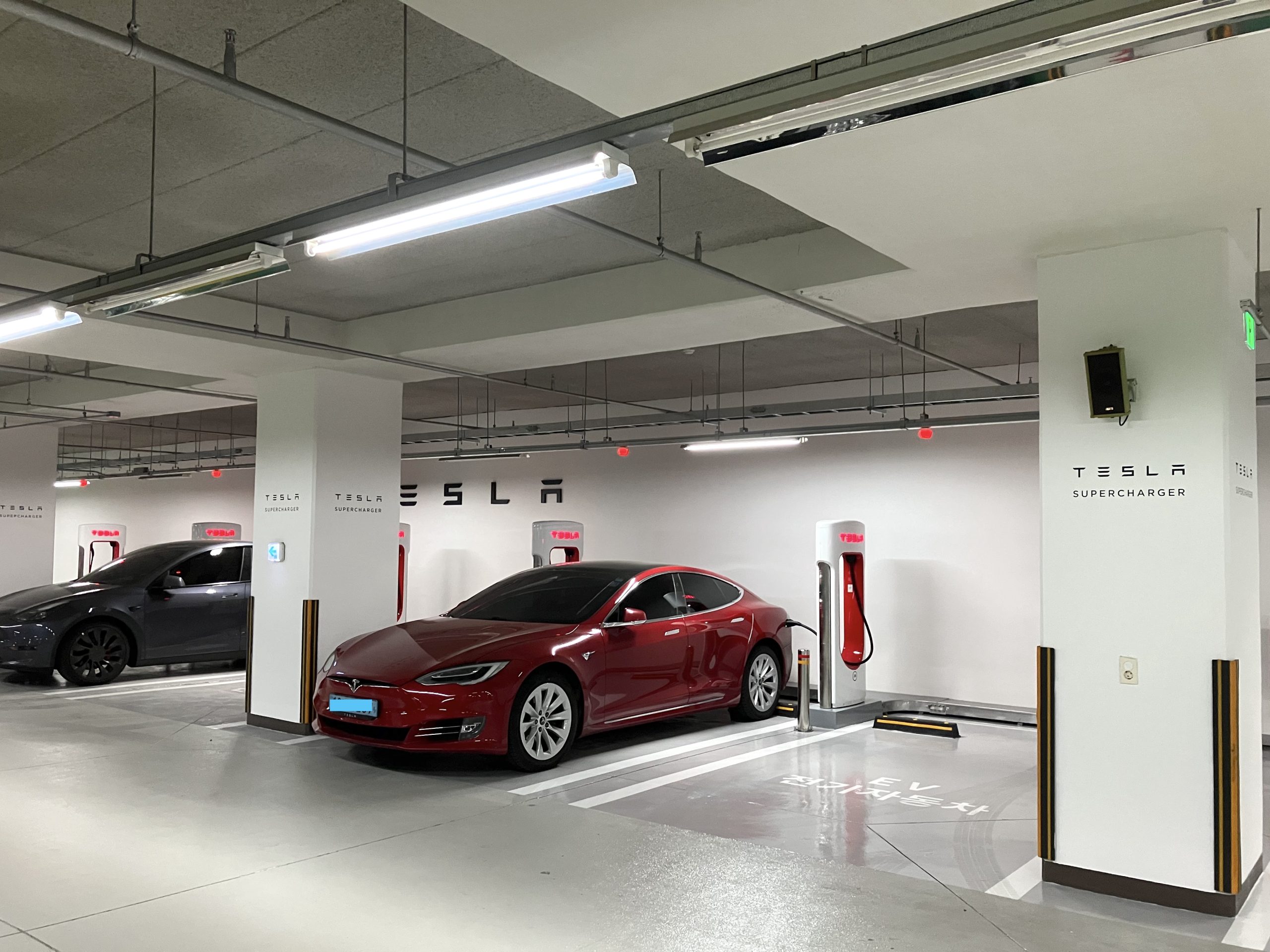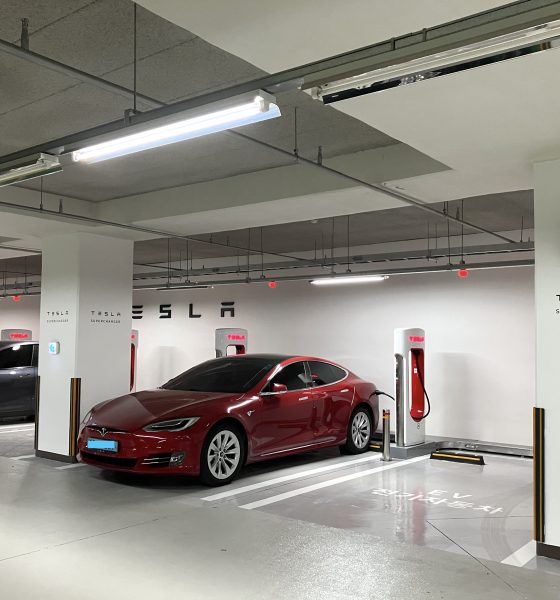As the auto industry transitions to electric vehicles (EVs), many have aired concerns that there will not be enough charging stations. According to one new report, many landlords and real estate owners in Los Angeles, California are rushing to construct new EV charging hardware at apartments, stores, office buildings and more.
Charging stations are not only considered a necessity for new housing developments in Los Angeles, according to the LA Times, but they’re also an opportunity for owners of convenience stores, fast food restaurants, gas stations, movie theaters and other retailers to make money while EV owners charge. Tesla and other companies are rapidly deploying new charging stations across the country, and the company recently built its 50,000th Supercharger stall.
Still, it’s difficult to say if the efforts to expand charging networks are enough, as many in the Los Angeles metro have pointed out.
One planning commissioner demanded project manager Hamid Behdad, who was overseeing a $350 million condominium skyscraper project in Los Angeles, to quadruple the number of charging stations at the project. Behdad eventually agreed to the last-minute change, now saying he’s “extremely glad that commissioner forced us” to build chargers at about 20 percent of the structure’s parking spots.
“When you are in the heat of the hearing in the last leg of the proposal, you aren’t going to say no,” Behdad said. “If we didn’t have these 90 chargers, we would be in real trouble selling units.”
As the demand for Tesla and other EVs continues to grow, many remain concerned about the state of the public charging infrastructure that will need to keep vehicles charged. The pace of EV adoption has accelerated rapidly in California, and it’s expected to follow suit throughout the U.S. in the coming years.
If demand wasn’t increasing enough on its own, California has also enacted a ban on the sale of new gas cars starting in 2035, and the move has since been followed by a number of states and even other countries.
One environmentally conscious housing developer, Cityview, is attempting to add as many charging stalls as allowed by a building’s electrical system. However, Cityview CEO Sean Burton notes that some older properties offer limited levels of available power supply for charging hardware, making it difficult.
“In general I think building owners are adopting more slowly than they should,” Burton said. “We try to be more leading edge on sustainability issues.”
ZRS Management, a property manager overseeing 76,000 apartment units is looking to retrofit power outlets in its garages to allow 210-volt, Level 2 charging, according to Vice President of Operations Jackie Impellitier. These systems can take roughly three to eight hours to charge an EV, and tenants have charging fees added to their utility bills.
“The thing we are all acknowledging is having charging stations is no longer an amenity, it’s a necessity,” Impellitier said of keeping tenants and garnering new ones. “We are going to start losing renters if we don’t have easy and convenient access” to chargers.
Several automakers, most recently including Jaguar, have signed on board to adopt Tesla’s North American Charging Standard (NACS), including plans to add the company’s charging port to their future EV releases. Ford was the first major automaker to adopt the equipment, as announced earlier this year in a Twitter Spaces call with Elon Musk. The company has since been joined by General Motors, Mercedes-Benz, Rivian, Hyundai, Honda and more.
What are your thoughts? Let me know at zach@teslarati.com, find me on X at @zacharyvisconti, or send your tips to us at tips@teslarati.com.

News
Tesla FSD fleet is nearing 7 billion total miles, including 2.5 billion city miles
As can be seen on Tesla’s official FSD webpage, vehicles equipped with the system have now navigated over 6.99 billion miles.

Tesla’s Full Self-Driving (Supervised) fleet is closing in on almost 7 billion total miles driven, as per data posted by the company on its official FSD webpage.
These figures hint at the massive scale of data fueling Tesla’s rapid FSD improvements, which have been quite notable as of late.
FSD mileage milestones
As can be seen on Tesla’s official FSD webpage, vehicles equipped with the system have now navigated over 6.99 billion miles. Tesla owner and avid FSD tester Whole Mars Catalog also shared a screenshot indicating that from the nearly 7 billion miles traveled by the FSD fleet, more than 2.5 billion miles were driven inside cities.
City miles are particularly valuable for complex urban scenarios like unprotected turns, pedestrian interactions, and traffic lights. This is also the difference-maker for FSD, as only complex solutions, such as Waymo’s self-driving taxis, operate similarly on inner-city streets. And even then, incidents such as the San Francisco blackouts have proven challenging for sensor-rich vehicles like Waymos.
Tesla’s data edge
Tesla has a number of advantages in the autonomous vehicle sector, one of which is the size of its fleet and the number of vehicles training FSD on real-world roads. Tesla’s nearly 7 billion FSD miles then allow the company to roll out updates that make its vehicles behave like they are being driven by experienced drivers, even if they are operating on their own.
So notable are Tesla’s improvements to FSD that NVIDIA Director of Robotics Jim Fan, after experiencing FSD v14, noted that the system is the first AI that passes what he described as a “Physical Turing Test.”
“Despite knowing exactly how robot learning works, I still find it magical watching the steering wheel turn by itself. First it feels surreal, next it becomes routine. Then, like the smartphone, taking it away actively hurts. This is how humanity gets rewired and glued to god-like technologies,” Fan wrote in a post on X.
News
Tesla starts showing how FSD will change lives in Europe
Local officials tested the system on narrow country roads and were impressed by FSD’s smooth, human-like driving, with some calling the service a game-changer for everyday life in areas that are far from urban centers.

Tesla has launched Europe’s first public shuttle service using Full Self-Driving (Supervised) in the rural Eifelkreis Bitburg-Prüm region of Germany, demonstrating how the technology can restore independence and mobility for people who struggle with limited transport options.
Local officials tested the system on narrow country roads and were impressed by FSD’s smooth, human-like driving, with some calling the service a game-changer for everyday life in areas that are far from urban centers.
Officials see real impact on rural residents
Arzfeld Mayor Johannes Kuhl and District Administrator Andreas Kruppert personally tested the Tesla shuttle service. This allowed them to see just how well FSD navigated winding lanes and rural roads confidently. Kruppert said, “Autonomous driving sounds like science fiction to many, but we simply see here that it works totally well in rural regions too.” Kuhl, for his part, also noted that FSD “feels like a very experienced driver.”
The pilot complements the area’s “Citizen Bus” program, which provides on-demand rides for elderly residents who can no longer drive themselves. Tesla Europe shared a video of a demonstration of the service, highlighting how FSD gives people their freedom back, even in places where public transport is not as prevalent.
What the Ministry for Economic Affairs and Transport says
Rhineland-Palatinate’s Minister Daniela Schmitt supported the project, praising the collaboration that made this “first of its kind in Europe” possible. As per the ministry, the rural rollout for the service shows FSD’s potential beyond major cities, and it delivers tangible benefits like grocery runs, doctor visits, and social connections for isolated residents.
“Reliable and flexible mobility is especially vital in rural areas. With the launch of a shuttle service using self-driving vehicles (FSD supervised) by Tesla in the Eifelkreis Bitburg-Prüm, an innovative pilot project is now getting underway that complements local community bus services. It is the first project of its kind in Europe.
“The result is a real gain for rural mobility: greater accessibility, more flexibility and tangible benefits for everyday life. A strong signal for innovation, cooperation and future-oriented mobility beyond urban centers,” the ministry wrote in a LinkedIn post.
News
Tesla China quietly posts Robotaxi-related job listing
Tesla China is currently seeking a Low Voltage Electrical Engineer to work on circuit board design for the company’s autonomous vehicles.

Tesla has posted a new job listing in Shanghai explicitly tied to its Robotaxi program, fueling speculation that the company is preparing to launch its dedicated autonomous ride-hailing service in China.
As noted in the listing, Tesla China is currently seeking a Low Voltage Electrical Engineer to work on circuit board design for the company’s autonomous vehicles.
Robotaxi-specific role
The listing, which was shared on social media platform X by industry watcher @tslaming, suggested that Tesla China is looking to fill the role urgently. The job listing itself specifically mentions that the person hired for the role will be working on the Low Voltage Hardware team, which would design the circuit boards that would serve as the nervous system of the Robotaxi.
Key tasks for the role, as indicated in the job listing, include collaboration with PCB layout, firmware, mechanical, program management, and validation teams, among other responsibilities. The role is based in Shanghai.
China Robotaxi launch
China represents a massive potential market for robotaxis, with its dense urban centers and supportive policies in select cities. Tesla has limited permission to roll out FSD in the country, though despite this, its vehicles have been hailed as among the best in the market when it comes to autonomous features. So far, at least, it appears that China supports Tesla’s FSD and Robotaxi rollout.
This was hinted at in November, when Tesla brought the Cybercab to the 8th China International Import Expo (CIIE) in Shanghai, marking the first time that the autonomous two-seater was brought to the Asia-Pacific region. The vehicle, despite not having a release date in China, received a significant amount of interest among the event’s attendees.










